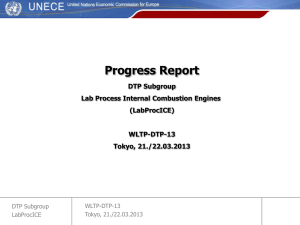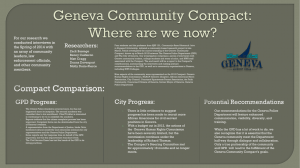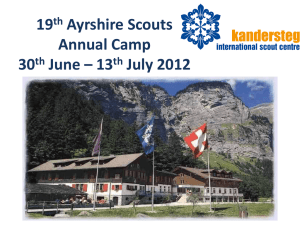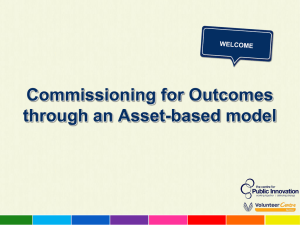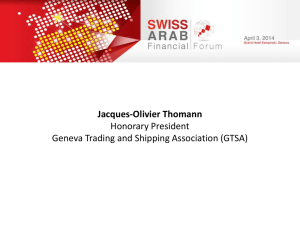WLTP-DTP-12-2 - LabProcICE Progress…
advertisement
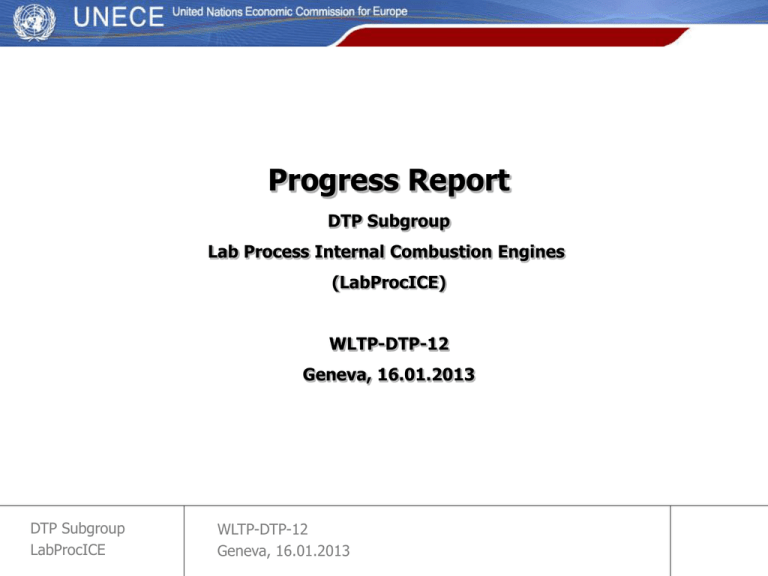
Progress Report DTP Subgroup Lab Process Internal Combustion Engines (LabProcICE) WLTP-DTP-12 Geneva, 16.01.2013 DTP Subgroup LabProcICE WLTP-DTP-12 Geneva, 16.01.2013 slide 1 Overview 1) State of the working progress 2) Issues on DTP Level 3) Validation phases 2 and 3 4) Work in progress items / proposals / open issues 5) Next steps DTP Subgroup LabProcICE WLTP-DTP-12 Geneva, 16.01.2013 slide 2 Meetings since DTP-11 • several dates Draft working team meetings • 14. – 16.11.2012 Brussels workshop - evaluation of validation 2 results - road load determination - joined meeting with EV Group minutes: LabProcICE-171 • 06.12.2012 Phone/web conference - comparison of RLD methods DTP Subgroup LabProcICE WLTP-DTP-12 Geneva, 16.01.2013 slide 3 Overview 1) State of the working progress 2) Issues on DTP Level 3) Validation phases 2 and 3 4) Work in progress items / proposals / open issues 5) Next steps DTP Subgroup LabProcICE WLTP-DTP-12 Geneva, 16.01.2013 slide 4 WLTP flexibilities (LabProcICE-151 / -152 / -153) Even improved test procedures with tightened tolerances will allow to use flexibilities in a systematic manner and might still lead to discrepancies between type approval and 'real-world' CO2 values. EU-Com proposal: Correction / normalization of measured CO2 emissions LabProcICE feedback: approach might shorten discussions on gtr test procedure tolerances impact on WLTP roadmap? Chair requested feedback on the feasibility of proposed normalization methods (see Annex of LabProcICE-151) DTP Subgroup LabProcICE WLTP-DTP-12 Geneva, 16.01.2013 slide 5 Expected decision at DTP-12: Implement such an approach (a) in WLTP gtr or (b) on regional level only by interested contracting parties? DTP Subgroup LabProcICE WLTP-DTP-12 Geneva, 16.01.2013 slide 6 Test mass / vehicle selection / inertia classes Review of DTP status: Approach from T&E / NL / ICCT includes: (1) vehicle test mass improved definition (incl. optional equipment, luggage/payload) Testing worst and in addition best case (if requested by manufacturer) (2) optional body parts influencing the aerodynamics Detailed discussion of alternative approaches at f2f-meeting (3) step-less inertia DTP Subgroup LabProcICE WLTP-DTP-12 Geneva, 16.01.2013 slide 7 Open Issues (a) Payload factors Current LabProcICE proposal : M1 15%, N1 35% (based on EU data) Analysis of data from Japan showed the following payload factors: -non commercial usage: 10 to 15 % -commercial usage: 30 to 35 %. Solutions: (1) Exclude payload from gtr test mass approach regional decision (2) Define 2 harmonized payload levels (low & high) in gtr, e.g. 15% and 30%. allocation to the respective vehicle classes on regional level. DTP Subgroup LabProcICE WLTP-DTP-12 Geneva, 16.01.2013 slide 8 (b) Consideration of aerodynamic features • The vehicle shall be tested 3 times (3 coastdowns, 3 CO2 tests) to define the maximum bandwidth for CO2 values TML without aerodynamic features TMH without aerodynamic features and worst case • intermediate values for individual features to be calculated and added to TM CO2 value • extrapolation within a certain range should be possible Aerodyn. worst case CO2 DCO2 Aero CO2 Bandwidth of individual vehicle TM CO2 individual values for each feature No aerodynamic features installed No aerodynamic features installed mass TML DTP Subgroup LabProcICE TM WLTP-DTP-12 Geneva, 16.01.2013 TMH Consideration of movable parts LabProcICE decision to be based on data regarding the expected CO2 impact of such parts, e. g. spoiler, air shutters, level of vehicle: (a) Low impact: “movable parts shall operate as intended under normal driving conditions” (b) Unknown impact: - Worst case setting as starting point. - Deviations depending on usage time or if the aerodynamic impact of the worst case setting is below defined thresholds. Japan supported option (b) because of unknown future parts and impacts DTP Subgroup LabProcICE WLTP-DTP-12 Geneva, 16.01.2013 slide 10 (c) Tyre selection criteria 1. Select tyre from the worst rolling resistance class (based on EU tyre labelling directive, RR measured in acc. with UN-R117, tyres offered by manufacturer for series of production) 2. Select widest tyre (offered by manufacturer for series of production) within the worst class EU-COM at DTP-11: consideration of tyre categories (C1, C2, …) proposal from ACEA expected for discussion in LabProcICE 3. Open issue regarding wheel rim selection: - rim with highest aerodynamic drag (worst case approach) or - consider rims as aerodynamic options? decision to be based on data regarding the expected CO2 impacts DTP Subgroup LabProcICE WLTP-DTP-12 Geneva, 16.01.2013 slide 11 Proposal: Three steps for Tyre selection for Road load determination Open Issue: Aero Cd Rolling Resistance Wheel Rim4 RR-Classn+2 (2) Widest Tyre (1) Highest RR-Class Wheel Rim3 Wheel Rim2 Wheel Rim1 RR-Classn+1 (3) Use wheel rim with highest aero drag option: (3) Consider Wheel Rims as aerodynamic options RR-Classn SelectableTyres Vehicle Family DTP Subgroup LabProcICE WLTP-DTP-12 Geneva, 16.01.2013 slide 12 Method of subtraction of intake air Aim: measure low pollutant mass with higher accuracy by considering the pollutant level that is contained in the combustion and intake air of the vehicle (LabProcICE-020) Concerns by US EPA / Japan DTP-08: Issue put on hold until results of validation and correlation show the clear need and effect of the proposed method No measurements during validation 2 Proposal withdrawn DTP Subgroup LabProcICE WLTP-DTP-12 Geneva, 16.01.2013 slide 13 Table of running resistances (LabProcICE-167 by PSA) • Need for table as an alternative to measurement methods agreed. • General objective by EU-COM: default factors should represent worst case to prevent an incentive to use the table instead of the measurement methods JRC will scrutinize the proposal counterproposal if necessary Comparison of RLD measurement methods • EU-COM at DTP-11: equivalency of methods to be evaluated • TelCo 6.12.2012 (LabProcICE-167 /-172 /-173) pros&cons + need for each method (coast down, torque meter, windtunnel) evaluation needs to be continued DTP Subgroup LabProcICE WLTP-DTP-12 Geneva, 16.01.2013 slide 14 Multimode gear boxes Emissions testing proposal: Test agreed worst case Compliance with emissions standards in all modes Exemptions for modes used in very limited conditions CO2 / FE testing proposal: (a) Single default mode test default mode (b) No default mode or multi default modes test best and worst case, average results of both modes Additional provisions: - Manufacturer shall give evidence to authority about the emission and fuel economy in the different modes - Tested options be provided in test report, e.g. for In-Service-testing DTP Subgroup LabProcICE WLTP-DTP-12 Geneva, 16.01.2013 slide 15 Reservation with regard to default mode procedure by COM & NL proposal: average best and worst case even in case of a single default mode DTP-9: validation 2: some labs should test all modes of single default mode vehicles decision on how to handle these vehicles afterwards Validation2: no input LabProcICE will keep proposal ___________________________________________________ GSI • Automotive Industry will provide proposal for GSI procedure • General question: follow fixed gear shift points and/or GSI? DTP Subgroup LabProcICE WLTP-DTP-12 Geneva, 16.01.2013 slide 16 Soak procedure Alternative 1: At least 6 hours and maximum of 36 hours until the engine oil temperature and coolant, if any, are within 298 K ± 2 K. (forced cooling down with open bonnet at the request of the manufacturer) Alternative 2: At least 12 hours and maximum 36 hours, with closed bonnet in soak area environment without using a cooling fan. Validation 2: First evalution of results showed that vehicle temperatures after 6h with forced cooling down show an equivalent temperature level to 12 -36 h DTP Subgroup LabProcICE WLTP-DTP-12 Geneva, 16.01.2013 slide 17 Objectives from EU stakeholders: 12 h soaking at 25°C is not representative for real life. vehicle (oil) temperature criteria shall not be dropped (alternative 2) Automotive industry: real life benefits of vehicles with insulation are disregarded by setting a target temperature DTP-12 advice needed: Principle approach to get a reproducible / normalized result: 1) defining a target setpoint vehicle temperature and / or (?) 2) defining a representative soak method / time. DTP Subgroup LabProcICE WLTP-DTP-12 Geneva, 16.01.2013 slide 18 Overview 1) State of the working progress 2) Issues on DTP Level 3) Validation phases 2 and 3 4) Work in progress items / proposals / open issues 5) Next steps DTP Subgroup LabProcICE WLTP-DTP-12 Geneva, 16.01.2013 slide 19 Overview of LabProcICE Evaluation Issues for Validation Phase 2 1.1 Soak Temperature Tolerances LabProcICE-154 1.2 Soak with forced Cooling down Part 1 1.3 Test Cell Temperatures 1.4 Tolerances of Humidity during Test Cycle 2.1 Tolerances of Emission Measurement System LabProcICE-155 2.2 Subtraction of Intake Air Part 2 3.1 Inertia setting 3.2 WLTC gearshift tolerance LabProcICE-156 3.3 OBD during WLTC Part 3 3.4 Preconditioning Cycle 3.5 Preconditioning for Dilution Tunnel 3.6 Tolerances for Dyno Load Setting 3.7 Speed Trace Tolerances 3.8 Handling of GSI 3.9 Monitoring of RCB of all Batteries 3.10 Exhaust Pressure before Remote Mixing Tee or CVS 3.11 Proportional Fan Position 3.12 Cycle Mode Construction 3.13 Required Time for Bag Analysis 3.14 Dilution Factor 3.15 Dyno Operation Mode DTP Subgroup LabProcICE WLTP-DTP-12 Geneva, 16.01.2013 slide 20 Validation phase 2 Evaluation of LabProcICE issues based on Validation 2 data base LabProcICE in close cooperation with Heinz Steven Last f2f meeting: Review of preliminary results documents: LabProcICE-154, LabProcICE-155, LabProcICE-156 Discussion of important issues with initial proposals Conclusion: Final data base needed for concluding evaluation Roadmap needs to be adapted! Important: All Contracting Parties are encouraged to evaluate the data base and come up with proposals DTP Subgroup LabProcICE WLTP-DTP-12 Geneva, 16.01.2013 slide 21 Validation phase 2 example – soak temperatures 6 Number of tests: 211 (no forced cooling down) 5 4 Increasing maximum deviation of soak temperature 3 1 0 -1 Delta T [K] 2 -2 -3 soak temp tolerances: 90% of tests are below ± 3 K of the set point 0% 10% 20% 30% 40% 50% 60% percentage of tests T_min-ave DTP Subgroup LabProcICE WLTP-DTP-12 Geneva, 16.01.2013 T_max-ave -4 -5 70% 80% 90% -6 100% 5 min average slide 22 Validation phase 2 example – test cell temperatures 8 7 Number of tests: 949 6 5 Increasing maximum deviation of test cell temperature during wltc 4 3 1 0 -1 Delta T [K] 2 -2 -3 -4 -5 Test cell temp tolerances: 90% of tests are below ± 4 K of the set point 0% 10% 20% 30% 40% 50% 60% percentage of tests T_min_amb DTP Subgroup LabProcICE WLTP-DTP-12 Geneva, 16.01.2013 T_max_amb -6 -7 70% 80% 90% -8 100% 1 Hz data slide 23 Validation phase 2 example – lab temperatures Temperature Soak and Test Cell +5 K Soak Area 6 -3 6 h Start of Test Test Cell during Phase I I Phase I I I "no syst emat ic deviat ion" Setpoint -5 K Actual Value Phase I DTP Subgroup LabProcICE WLTP-DTP-12 Geneva, 16.01.2013 slide 24 Current EU legislation: soak, test start and test cell temperatures have a tolerance of ± 5 K Initial LabProcICE proposal for tolerances: Soak tolerance: ± 3 K (5 min average) Test start: ± 2 K (1 Hz values) Lab temperature: ± 5 K (1 Hz values) LabProcICE boundary conditions for lab temperature setpoint: • • validation 2 setpoint: 25 °C between 20 – 30 °C (harmonization with US) DTP Subgroup LabProcICE WLTP-DTP-12 Geneva, 16.01.2013 slide 25 Validation phase 3 Japan introduced status report (LabProcICE-165) at f2f meeting: • Validation measurements are still on going. • Main task: warming up procedure several options will be evaluated comparison between stabilized coast down after warm up and a non-stabilized coast down will also be foreseen to evaluate benefit. DTP Subgroup LabProcICE WLTP-DTP-12 Geneva, 16.01.2013 slide 26 Possible issues for post-validation • GSI handling • Monitoring of RCB of all batteries • Handling of areodynamic options within test mass approach • Normalization methods In addition: • DTP Subgroup LabProcICE Need to evaluate equivalency of RLD measurement methods by further studies? WLTP-DTP-12 Geneva, 16.01.2013 slide 27 Overview 1) State of the working progress 2) Issues on DTP Level 3) Validation phases 2 and 3 4) Work in progress items / proposals / open issues 5) Next steps DTP Subgroup LabProcICE WLTP-DTP-12 Geneva, 16.01.2013 slide 28 Open issues LabProcICE open issues are listed in the gtr draft documents, see comments of S. Dubuc (Drafting Coordinator) Other proposals and work in progress items: - Deletion of on-board anemometer based coast down method - Tyre conditioning - … DTP Subgroup LabProcICE WLTP-DTP-12 Geneva, 16.01.2013 slide 29 Overview 1) State of the working progress 2) Issues on DTP Level 3) Validation phases 2 and 3 4) Work in progress items / proposals / open issues 5) Next steps DTP Subgroup LabProcICE WLTP-DTP-12 Geneva, 16.01.2013 slide 30 Next steps • Telephone Conference in February 2013 (tbc) • DC drafting sessions • f2f-Workshop in Brussels: 20.02.2013: hosted by AECC 21.02.2013: hosted by ACEA DTP Subgroup LabProcICE WLTP-DTP-12 Geneva, 16.01.2013 slide 31 Thanks for your attention. LabProcICE contact: Béatrice Lopez de Rodas - beatrice.lopez(at)utac.com Konrad Kolesa - konrad.kolesa(at)audi.de Stephan Redmann – stephan.redmann(at)bmvbs.bund.de DTP Subgroup LabProcICE WLTP-DTP-12 Geneva, 16.01.2013 slide 32

